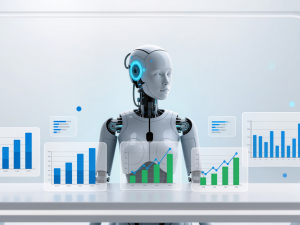A classroom that adjusts itself while students are still learning, that’s no longer science fiction; it’s data-driven education. Professors today aren’t waiting until midterms to find out who’s struggling or which lessons aren’t landing. Instead, dashboards filled with live performance data are reshaping how they teach, moment by moment.
This real-time feedback loop is what makes modern classrooms smarter. Every student click, quiz score, and discussion thread tells a story about how well the material is connecting. Learning analytics collect those stories, helping professors see patterns of who’s losing focus, who’s ready to move ahead, and what content sparks the most engagement.
It’s a shift from reaction to anticipation. Rather than relying on end-of-semester assessments, professors can now adapt their approach mid-lesson. If data shows comprehension dipping, they can introduce a new resource or change their method instantly. If engagement spikes during visual content, they can lean on that insight for future classes.
This isn’t about replacing intuition with algorithms; it’s about combining both. The intuition of a teacher, guided by the precision of data, is redefining what responsive teaching means. And as learning analytics become more advanced, professors are discovering that the real secret to better outcomes lies in understanding students not just as a class, but as individuals in constant motion.
How Analytics Help Professors Personalise Lessons?
Every student learns differently. That’s been true for as long as classrooms have existed. What’s changed is that professors can now see those differences in real time and respond to them with precision. Learning analytics give educators the power to move beyond one-size-fits-all teaching and build lessons that adapt to each learner’s strengths, pace, and preferences.
Adaptive learning platforms are at the centre of this shift. These systems analyse student behaviour, such as how long they spend on questions, where they hesitate, what kind of content they interact with most and use that information to create customised learning paths. If a student is struggling with a concept, the platform automatically serves up extra practice material or explains it in a new way. If they’re advancing quickly, it offers tougher challenges to keep them engaged.
This same data also helps professors fine-tune how they teach. Through engagement analysis, they can track who’s logging in regularly, which videos hold attention the longest, and which assignments generate the most discussion. If participation drops during a certain module, that’s a signal to rework the format, maybe by adding visuals, breaking the lesson into smaller parts, or creating more interactive exercises.
The result is a classroom that feels more personal and responsive. Professors aren’t guessing what’s working; they know. They can identify where curiosity spikes and confusion sets in, using this insight to adjust the pace, tone, or type of content used.
Personalisation powered by analytics doesn’t replace good teaching; it enhances it. It provides educators with the tools to teach the same material in ways that feel entirely different to each student, transforming passive learning into a tailored, dynamic experience that evolves as the class does.
How Analytics Help Predict and Address Student Challenges?
The best professors have always had a sixth sense, a way of knowing when a student is starting to fall behind. Learning analytics takes that instinct and gives it data to back it up. With real-time insights, professors can identify problems before they escalate, eliminating the need to wait for failing grades or skipped classes. The warning signs are already on the screen.
Predictive analytics track performance trends, engagement levels, and behavioural cues to identify students who might be at risk academically or otherwise. For instance, a sudden drop in quiz scores, lower login frequency, or incomplete assignments can trigger an alert. These early warning systems act like a digital safety net, giving professors a chance to step in before a setback becomes a crisis.
Once a student is flagged, instructors can take proactive action. That might mean recommending tutoring, adjusting deadlines, offering one-on-one guidance, or sharing targeted study resources. The goal isn’t to punish poor performance — it’s to understand it, address it, and help students recover faster.
Analytics also help uncover patterns within the class. If several students struggle with the same topic, it might signal a gap in the lesson itself rather than individual effort. Professors can then revisit that concept in the next class, rework their explanations, or add supporting materials.
But the most powerful use of data comes when it looks beyond academics. Attendance patterns, engagement drops, or abrupt behaviour changes can point to external pressures from financial stress to burnout. By connecting students with counselling or academic support early, educators can make timely interventions that go beyond grades.
In essence, analytics give professors something every student needs but few receive: personalised support at the right time. It’s not about catching mistakes, it’s about catching potential, and helping it stay on course.
How Analytics Inform Course Redesign?
A great course isn’t just about what we see at the end today; it’s about harnessing data power evolution. Learning analytics give professors a backstage view of how students actually experience their courses, making it easier to refine what works and reimagine what doesn’t.
Instead of relying on end-of-term feedback or course surveys, professors now have real-time evidence of what’s effective. They can identify which teaching strategies lead to higher engagement, which materials cause coconfusew different assessment formats impact performance. This turns course redesign from a guesswork process into an evidence-based one.
For example, if analytics show that students consistently struggle with a specific module, it’s a clear signal that the content needs attention. The professor might simplify explanations, introduce interactive examples, or use visual simulations to make the concept clearer. Over time, each round of teaching becomes smarter and more refined, a living curriculum that improves with every student interaction.
Analytics also reshape how assessments are designed. By studying exam and quiz data, educators can pinpoint which questions are too difficult, too easy, or misleading. Adjusting those elements ensures that tests measure understanding, not memorisation or luck. This makes evaluations more accurate and fair for everyone.
On a larger scale, data support institutional accountability. When professors propose a new tool, method, or course structure, they can back it up with solid numbers showing improved outcomes. That kind of evidence not only drives innovation but also secures funding, earns administrative trust, and validates the time spent redesigning a course.
In the end, analysts turn course development into a continuous feedback loop. The more students learn, the more data educators collect. The more data they collect, the better they can teach. And that cycle of improvement never stops.
The Human Side of Data-Driven Teaching
Behind every chart, graph, and dashboard is something data alone can’t measure: the human connection that makes teaching meaningful. While analytics provide precision and insight, it’s still the professor’s intuition and empathy that give those numbers purpose.
Data might reveal that a student’s engagement is dropping, but it takes a teacher to ask why. Perhaps the student is feeling overwhelmed, uninspired, or struggling with issues outside the classroom. That’s where human judgment steps in, turning information into understanding. The best professors don’t use analytics to monitor students; they use it to reach them.
This balance between numbers and nuance is what makes data-driven teaching so powerful. Analytics identifies patterns, gaps, trends, and triggers, while educators focus on the individuals behind them. A dashboard can show that a concept isn’t sticking, but only a teacher can decide whether it needs to be re-taught, reimagined, or discussed face-to-face.
It’s also about trust. Students engage more deeply when they know their data is being used to help them, not to judge them. When professors share insights, transparently explaining how analytics improve lessons or tailor feedback, it builds a collaborative environment where technology becomes a partner, not an overseer.
Ultimately, data enhances teaching, but it doesn’t define it. The real transformation happens when professors combine their human instincts with analytical insight, blending compassion with precision to create classrooms that don’t just teach efficiently, but care deeply.
What is the Future of Data-Driven Education?
The classrooms of tomorrow won’t just be smart, they’ll be aware. As technology continues to evolve, data-driven teaching is moving beyond dashboards and reports toward systems that can sense, adapt, and respond to learners almost instinctively.
Artificial intelligence will play a major role in this next phase. AI-powered analytics will soon be able to predict not only when a student might struggle, but why. By analysing learning patterns, sentiment in written work, and even tone in discussion forums, these systems will understand emotional engagement alongside academic performance. A student who’s technically performing well but showing signs of burnout might receive prompts for mindfulness exercises or messages of encouragement from their professor.
Virtual and augmented reality will also join the mix, turning data into immersive, responsive experiences. Professors could soon use performance data to adjust difficulty levels within a simulation or automatically generate new problem sets tailored to each student’s skill level, creating lessons that evolve in real time.
At the same time, education systems will need to focus on ethical and transparent use of data. As analytics grow more powerful, questions of privacy, consent, and fairness will demand thoughtful answers. The goal isn’t to make students feel watched — it’s to make them feel understood.
The future of data-driven education won’t be about replacing teachers with algorithms or reducing students to statistics. It’ll be about designing learning systems that are responsive, empathetic, and inclusive. A world where professors can teach with insight, students can learn with confidence, and every decision in the classroom is guided by both evidence and empathy.
Conclusion: When Data Meets Human Insight
Data is changing how professors teach, but the real magic lies in how they use it. Numbers alone can’t inspire a student, but when paired with human intuition, they can transform the entire learning experience.
A data-driven curriculum gives professors something they’ve always needed but never fully had: clarity. It shows what’s working, what’s not, and where every student stands, all in real time. That insight turns teaching into a living process, one that adapts, improves, and responds as learning unfolds.
But while technology offers precision, it’s empathy that brings direction. Data might highlight a struggle; only a teacher can turn that into support. Analytics may suggest change; only a teacher can make that change meaningful. Together, they create classrooms that are smarter, fairer, and more connected than ever before.
Education has always been about understanding people, their pace, their potential, and their needs. Data provides professors with the tools to see that understanding in sharper focus. And as these systems continue to evolve, one question remains worth asking: what could learning look like if every classroom adapted as quickly as the students inside it?
FAQs:
1. How is data analytics used in education?
Learning analytics collect information on student behaviour from attendance and assignment submissions to quiz scores and discussion activity. Professors use this data to spot patterns, adjust lessons, and personalise learning in real time, ensuring that every student receives the right support at the right moment.
2. Can analytics really improve learning outcomes?
Yes. When educators act on real-time insights, they can intervene before students fall behind and reinforce concepts that need more attention. Studies show that data-informed teaching leads to higher retention, stronger comprehension, and better overall engagement.
3. Do analytics replace teacher intuition?
Not at all. Analytics enhance intuition; they don’t replace it. Data provides clarity on what’s happening; intuition helps professors understand why it’s happening. The most effective classrooms combine both human judgment and data-driven insight.
4. How do universities ensure data privacy?
Institutions use strict privacy frameworks that anonymise student data and store it securely. Access is restricted to educators and administrators involved in academic support, ensuring data is used only to enhance learning, never to penalise students.
5. What’s next for data-driven teaching?
The next step is deeper personalisation through AI and predictive modelling. Soon, courses will adapt automatically to each learner’s pace and preferences, enabling professors to focus on mentorship and creative teaching while technology handles the analytics behind the scenes.






